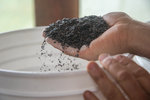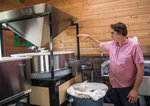On a drizzly Sunday morning, families, friends and neighbors warmed up at the Chimacum Grange, soaking up fresh blueberry syrup with buckwheat pancakes, sipping steamy cups of coffee and tapping their feet to live folk tunes.
This item is available in full to subscribers.
We have recently launched a new and improved website. To continue reading, you will need to either log into your subscriber account, or purchase a new subscription.
If you had an active account on our previous website, then you have an account here. Simply reset your password to regain access to your account.
If you did not have an account on our previous website, but are a current print subscriber, click here to set up your website account.
Otherwise, click here to view your options for subscribing.
* Having trouble? Call our circulation department at 360-385-2900, or email our support.
Please log in to continue |
|


On a drizzly Sunday morning, families, friends and neighbors warmed up at the Chimacum Grange, soaking up fresh blueberry syrup with buckwheat pancakes, sipping steamy cups of coffee and tapping their feet to live folk tunes.
The second annual Grange pancake feed on Sept. 22 saw 200 people come through to help the Grange raise money for renovations, eat good food and enjoy a morning of community.
But there was more to the plates of food than met the eye: everything that was eaten was locally grown, from the pork sausage to the melt-in-your-mouth cantaloupe.
“The pork came from happy pigs, who grew up out there on Egg and I road,” said James Fritz, a member of the Chimacum Grange board.
But there was one ingredient that is relatively new to Jefferson County’s agriculture community: buckwheat.
Keith Kisler, one of the owners and founders of Finnriver Farm and Cidery, grew the buckwheat that made Sunday’s pancakes hearty. Buckwheat is just one of the grains that Kisler is beginning to grow, mill and process at Finnriver Farm for what he hopes is the beginning of a grain business.
Kisler grew up on a grain farm in Eastern Washington. When he and his wife Crystie first started Finnriver Farm, he began growing some grain crops and milling on a small mill, selling bags of flour to prospective buyers.
Soon the cidery took over his life and the flour business was pushed to the background for a while.
“It’s always been my desire to grow organic grain,” Kisler said. While the cidery business took off, he continued to grow different types of grain for the Washington State University’s bread lab, a program that works to breed and develop varieties of grains and other crops that will benefit farmers, processors, and communities.
With the Bread Lab’s Dr. Stephen S. Jones, Kisler has become interested in how grains grow in the Olympic Peninsula’s rainshadow climate. Sequim Prairie organic farmer Nash Huber developed a number of markets for local grains, raising spelt, quinoa and wheat that makes its way to commercial bakeries and retail outlets. Indeed, the pancakes included flour from Nash’s Organics line.
“I haven’t read a novel in about 15 years,” Kisler joked. “I spend most of my time reading academic journals.”
Kisler is constantly researching different types of grain, the health benefits of whole grains and different grain farming techniques.
“The Bread Lab is all about nutritional quality and end-use quality,” Kisler said.“
Now that Finnriver is building a new cider processing barn on their property at the corner of Center Road and Highway 19, their old cider barn is slated to become Kisler’s new grain milling operation.
He plans to begin his small grain growing and milling operation with milled-to-order grains, such as wheat, barley, buckwheat, quinoa and spelt.
Partnering with bakeries like Pane D’Amore and individual bakers, he will traditionally stone-grind grain for bread, pastries and, of course, pancakes.
GROWING BUCKWHEAT
Though the name might suggest otherwise, buckwheat is not actually a form of wheat. Often grown as a cover crop because of its ability to shade out weeds, buckwheat seeds are a pseudo grain that can be ground into a flour and used in breads, pancakes, and most commonly in France’s traditional savory crepes.
This summer, Kisler’s field of buckwheat flowered prettily on the side of Center Road, across from Red Dog Farm. A spring grain, it is planted as winter ends and harvested in the summer.
The grain constantly flowers, which means it constantly sets seed and a mixture of the black cured seed can be harvested at the same time as newer green seed.
When 75 percent of the seeds are cured, Kisler cuts the buckwheat and windrows it for a week to 10 days, which helps the grain mature even further.
Then, it is run through a combine, which threshes the grain, releasing small, black grains—the edible part—from the chaff.
Growing up on a grain farm in Eastern Washington, these processes are all incredibly familiar for Kisler, but at world-feeding industrial scale. This tiny operation had its own challenges, such as finding machinery appropriate to Finnriver’s small acreages.
“Some of the machines they use over there wouldn’t even fit on the road to get back here,” he said.
His most recent machinery purchase has been a traditional stone grind mill, which can pound buckwheat and sort the product into three different textures: a white flour, a medium whole grain flour, and the leftover hulls which can be used in fabrics.
In the pancakes, Grange volunteer and Chimacum Corner Farmstand owner Katy McCoy used a mixture of the white flour and sifted flour, which contained the darker and grainier texture and gave the pancakes a hearty buckwheat flavor and color.
Buckwheat has a high mineral content, high fiber and the vitamin Rutin which is an antioxidant that can protect the heart, liver and bones.
For Kisler, his burgeoning grain business is all about whole grains.
Grains, like any crops, have genetic lines that give them unique characteristics. But with the popularity of white flour and the uniformity of modern grain production, many whole grains have lost some of their genetic characteristics over the years, Kisler said.
“The most beautiful wheat I’ve ever grown was for the Bread Lab and was three different breeding lines mixed together,” he said. “It was dark, uniform, had no disease, grew well and milled well.”
The Bread Lab is working to bring some of those interesting grains back into popularity, so that they are easy to grow for farmers like Kisler and so that communities can enjoy bread that is healthy, tasty, and locally made.